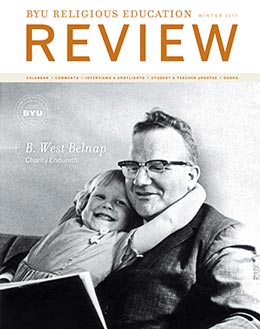Scott C. Esplin (scott_esplin@byu.edu) is an assistant professor of Church history and doctrine at BYU.
The Church Educational System is charged with providing spiritual and secular learning for Church membership worldwide. While the program currently serves over 700,000 students in 141 countries and territories, its history is rooted in the early mission of religious education at BYU. Instructing principal Karl G. Maeser on how to lead the school, Brigham Young famously emphasized religion’s role in the education of Zion’s youth: “Brother Maeser, I want you to remember that you ought not to teach even the alphabet or the multiplication tables, without the spirit of God. That is all. God bless you.”[1]
With the Spirit at the core of the institution’s mission, BYU became the model for all Church education. At the height of federal opposition to the Church in the 1880s, President John Taylor held up the institution as a pattern for others to follow. “The Brigham Young Academy, at Provo,” President Taylor declared, “[is] doing excellent work in this direction and should be patronized and sustained by the Latter-day Saints. In no direction can we invest the means God has given us to better advantage than in the training of our children in the principles of righteousness and in laying the foundation in their hearts of that pure faith which is restored on the earth. We would like to see schools of this character . . . started in all places where it is possible.”[2] Though President Taylor died before his wish could be fulfilled, his successor, Wilford Woodruff, accepted the challenge, forming the Church Board of Education in 1888 and implementing a Churchwide system of academies patterned after Brigham Young Academy. Remnants of these children institutions to BYU such as Weber State University, Snow College, Dixie State College, LDS Business College, Brigham Young University–Idaho, the College of Eastern Arizona, and the Juarez Academy continue to educate thousands of Church youth today.
A generation later, as the Church considered transferring most Latter-day Saint academies to public control, religious education at Brigham Young University continued to shape Church education policy. In addition to providing a pattern for Church education to follow, the university became the source for many of the system’s faculty. Arguing for a preservation of BYU in 1920, the Church Board of Education declared, “If . . . sufficient number of capable young men and women of the Church can be induced to graduate from the normal colleges and the BYU, and accept positions as leaders in the various public schools and high schools throughout the state, there should be no reason why these schools should not be permeated by a truly wholesome and upbuilding atmosphere of true morality.”[3] Accordingly, BYU emphasized preparing religiously grounded graduates trained to bless society in all fields of learning.
Today, the school continues in its original mission. Teaching truths bathed in the light of the Holy Spirit, BYU has guided Church education both by its pattern and by its product. By providing Spirit-centered instruction for a myriad of disciplines, religious education at BYU serves as a flagship for Church education worldwide.
Notes
[1] Reinhard Maeser, Karl G. Maeser: A Biography by His Son (Provo, UT: Brigham Young University, 1928), 79.
[2] John Taylor, in Messages of the First Presidency of the Church of Jesus Christ of Latter-day Saints, ed. James R. Clark (Salt Lake City: Bookcraft, 1966), 3:86–87.
[3] Minutes of the LDS General Board of Education, March 3, 1920, 25; in Jerry C. Roundy, Ricks College: A Struggle for Survival (Rexburg, ID: Ricks College Press, 1976), 99–100.
